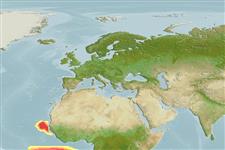Environment: milieu / climate zone / depth range / distribution range
Ökologie
seewasser bathypelagisch; tiefenbereich 0 - 1000 m (Ref. 6540). Deep-water
Eastern Atlantic: known only from two specimens caught off Cape Verde.
Size / Gewicht / Alter
Maturity: Lm ? range ? - ? cm
Max length : 5.7 cm TL Männchen/unbestimmt; (Ref. 27000)
Minimum depth from Ref. 58018.
Life cycle and mating behavior
Maturities | Fortpflanzung | Spawnings | Egg(s) | Fecundities | Larven
Bertelsen, E. and J.G. Nielsen, 1990. Monognathidae. p. 207. In J.C. Quero, J.C. Hureau, C. Karrer, A. Post and L. Saldanha (eds.) Check-list of the fishes of the eastern tropical Atlantic (CLOFETA). JNICT, Lisbon; SEI, Paris; and UNESCO, Paris. Vol. 1. (Ref. 6540)
IUCN Rote Liste Status (Ref. 130435)
Bedrohung für Menschen
Harmless
Nutzung durch Menschen
Tools
Zusatzinformationen
Download XML
Internet Quellen
Estimates based on models
Preferred temperature (Ref.
123201): 6.9 - 22.8, mean 7 °C (based on 3 cells).
Phylogenetic diversity index (Ref.
82804): PD
50 = 0.5001 [Uniqueness, from 0.5 = low to 2.0 = high].
Bayesian length-weight: a=0.00102 (0.00046 - 0.00225), b=3.06 (2.88 - 3.24), in cm total length, based on all LWR estimates for this body shape (Ref.
93245).
Trophic level (Ref.
69278): 3.2 ±0.5 se; based on size and trophs of closest relatives
Fishing Vulnerability (Ref.
59153): Low vulnerability (10 of 100).
